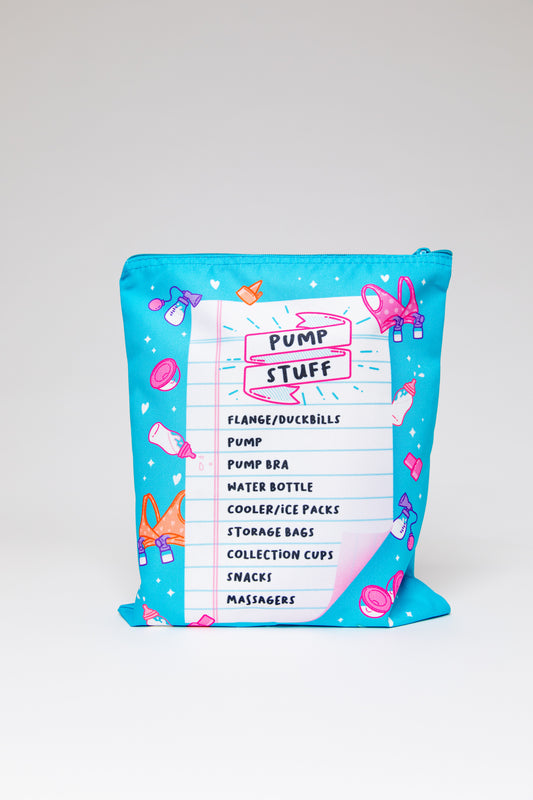
When feeding baby at the breast we watch their cue for direction when it’s time to feed. Baby is typically in the drivers seat, whether that’s a feeding every 2.5 hours or cluster feeding through the night. Our babies know what they need and they aren’t afraid to let us know!
But when if we are exclusively pumping, then what, how do we know who’s lead to follow?
The quick answer, our baby! Even though they may not be feeding at the breast they’re still not shy about when it’s time to eat. Understanding and recognizing their cues will still help us stay on a track, even while pumping. Similarly to baby feeding at the breast every 2.5 hours (respectfully), we should be emptying our breasts on a similar schedule. Unlike baby feeding at the breast, we are looking to double pump for a duration of 20-30 minutes at each session. Babies feeding schedules may vary duration, volume and boob to boob. While pumping we follow more of a strict routine; double pumping, set duration and schedule. This being said, we may not have to aim for a schedule of every 2.5 hours. Remember, the more milk we demand at the breast, in theory, the more we will produce. The issue with pumping every 2.5 hours, following a similar schedule of a nursing baby is the risk of demanding a large over supply.
We know babies will feed 8-12 times in a 24 hour period.. at the breast or by bottle. When translated over to pumping, we stay in the mind set that we need to pump every 2.5 hours. There are variables that aren’t taken into account when speaking with a pumping mother, she may be double pumping and demanding production from both breasts simultaneously for longer durations of time vs feeding baby in possibly shorter bursts.
Following a pumping schedule is still imperative when encouraging and building your milk supply..
However, pumping every 2-2.5 hours may drive an unnecessary oversupply AND have you feeling like you’re constantly attached to a pump.
Based on based on my personal experience and exposure to the pumping community, I like to advise..
Pumping every 2.5 hours is not the most realistic nor encouraging schedule. As a pumping mom following a 3-3.5 hour schedule, double pumping for approximately 20-30 minutes at each session has the same effect and ability to drive your supply. What’s the big deal, one hour, thanks Kristen. It may not seem like much but I can assure you 1 hour in babyland can be all the difference.
The goal is to help set you up for success and a realistic journey. If I was told I needed to pump every 2.5 hours around the clock, I’d likely quit too. However if you’re giving me that extra cushion of 1 hour, granted you’re on a schedule of emptying both breast frequently and effectively, you should be on the road to success.
As you'll see below I start out strong at 8 pumps per day (8ppd). Once confident in my supply, routine and becoming regulated I begin to drop sessions one at a time. My recommendation would always be to drop slowly and watch to see if your supply decreases with the reduction in demand. Personally, I have found that once I drop to 3 pumps per day or below my body goes into weaning mode, you may find a similar case while decreasing time on the pump. Drop your desired session, rearrange your schedule and watch patiently to see what your supply equals out to- this may take a week to several weeks.
I want to remind you that pumping during the middle of the night (MOTN) is still essential whether you're feeding at the breast or pumping your breast milk. We are maximizing our prolactin levels during the hours of 2-5 am. Kelly Kendall quotes Kaia Lacey from @lowsupplymom, during our podcast recording Episode 28; Increasing Milk Supply with Kelly Kendall that even moving your pumping schedule to hit these early hours of the morning can help maximize your supply opposed to waiting later in the morning to pump or later in the evening.
Here are a few of my own schedules I have found beneficial to both my mindset and supply.
My 2018 exclusive pumping schedule for my multiples






Notice at 14mpp I was still pumping 3 times a day! There is no one schedule that fits all, if you choose to wean well before 14 months your schedule will look different than the one shared above.
Generally speaking, the schedules you find online will provide you with a 12 month plan. If you do not have an end insight, then your schedule will look very different than those provided samples. Be sure you do not drop too quickly if you're not set on a specific end date.
Here are more podcasts for your consideration!






